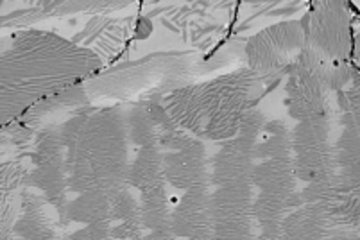All genres
281.
Talk
Atomic Scale Analysis of Interfaces: Gibbs Adsorption Revisited. Colloquium at Physics Department, University of Erlangen, Erlangen, Germany (2015)
282.
Talk
Nanostructuring metallic alloys through confined phase transformations. Colloquium Lecture - GDCh (Gesellschaft Deutscher Chemiker)
, Bielefeld, Germany (2015)
283.
Talk
Nanostructured steels: Hierarchical materials engineered down to the atomic scale. European Symposium on Martensitic Transformations, ESOMAT 2015
, Antwerp, Belgium (2015)
284.
Talk
Segregation engineering enables nanostructured bulk steels by confined martensite-to-austenite reversion. Asia Steel International Conference 2015 (Asia Steel 2015), Yokohama, Japan (2015)
285.
Talk
Nanostructured steels: Hierarchical materials engineered down to the atomic scale. ESOMAT 2015, Antwerp, Belgium (2015)
286.
Talk
Intrinisically nanostructured steels. Materials Week 2015, Dresden, Germany (2015)
287.
Talk
Grain boundary segregation enables nanostructured martensite-austenite laminates by solute decoration and phase transformation at defects. 10th European Symposium on Martensitic Transformations (ESOMAT), Antwerp, Belgium (2015)
288.
Talk
Hydrogen-assisted Failure in Nickel base alloy UNS N07718. Euromat 2015, Warsaw, Poland (2015)
289.
Talk
Segregation Engineering: Confined Phase States at Lattice Defects. Workshop "Recent Progress in Plasticity and Phase Transformations", Bochum, Germany (2015)
290.
Talk
Scale hoping simulations and real atoms. ICAMS Workshop ‘From Atoms to Continuum’,ICAMS, Ruhr University Bochum, Bochum, Germany (2015)
291.
Talk
Phase transformations at dislocations. Workshop Possibilities and Limitations of Quantitative Materials Modeling and Characterization, Bernkastel, Germany (2015)
292.
Talk
Low Temperature Austenite Reversion in Martensitic Stainless Steel. GLADD Meeting, Leuven, Belgium (2015)
293.
Talk
Lath martensite plasticity: A micro-strain mapping study coupled to 3D microstructure characterization. TMS 2015 144th Annual Meeting & Exhibition, Orlando, FL, USA (2015)
294.
Talk
Hydrogen-assisted Failure in Nickel base alloy UNS N07718. Corrosion 2016, Vancouver, Canada (2015)
295.
Talk
Lath martensite transformation, µ-plasticity and tempering reactions: potential TEM aids. Seminar at Institute of Nanotechnology (INT), Karlsruhe Institute of Technology (KIT), Karlsruhe, Germany (2015)
296.
Talk
Linear Complexions: Confined Chemical and Structural States at Dislocations in Metallic Alloys. MRS Fall Meeting & Exhibit, Boston, MA, USA (2015)
297.
Talk
Hydrogen Embrittlement and Sour Gas Corrosion in Oil and Gas Industry. Workshop: Hydrogen Embrittlement and Sour Gas Corrosion, Max-Planck-Institut für Eisenforschung, Düsseldorf, Germany (2015)
298.
Talk
Multi-scale characterization of ductile martensitic steels. Advanced Steels 2014, Madrid, Spain (2014)
299.
Talk
Segregation and phase transformation at dislocations during aging in a Fe-9%Mn steel studied by correlative TEM-atom probe tomography. MSE 2014, Darmstadt, Germany (2014)
300.
Talk
Segregation of boron at prior austenite grain boundaries in a quenched steel studied by atom probe tomography. Atom Probe Tomography & Microscopy 2014, Stuttgart, Germany (2014)











